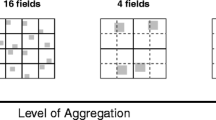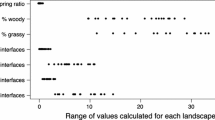Abstract
We report on the use of a spatially explicit model and clustering analysis in order to investigate habitat manipulation as a strategy to regulate natural population densities of the insect-pest Diabrotica speciosa. Habitat manipulation involved four major agricultural plants used as hosts by this herbivore to compose intercropping landscapes. Available biological parameters for D. speciosa on bean, soybean, potato and corn obtained under laboratory conditions were used to group the homogeneous landscapes, composed by each host plant, by a similarity measure of host suitability either for larval survival and development, and adult survival and fecundity. The results pointed corn as the most dissimilar culture. Therefore, intercropping corn with any other crop system tested could reduce insect spread through landscape. This was proved using a cellular automata model which simulate the physiological and behavioural traits of this insect, and also different spatial configurations of the intercropping. Spatio-temporal patterns obtained by simulations demonstrated that the availability of corn bordering the field edge, which are areas more likely to invasion, is key for insect population control.







Similar content being viewed by others
References
Altieri MA, Letourneau DK (1982) Vegetation management and biological control in agroecosystems. Crop Prot 4:405–430
Ávila CJ, Parra JRP (2002) Desenvolvimento de Diabrotica speciosa (Germar) (Coleoptera: Chrysomelidae) em diferentes hospedeiros. Ciência Rural 32:739–745
Ávila CJ, Parra JRP (2003) Leaf consumption by Diabrotica speciosa (Coleoptra:Chrysomelidae) adults on different host plantes. Scientia Agricola 60(4):789–792
Bjorkman M, Hamback PA, Hopkins RJ, Ramert B (2010) Evaluating the enemies hypothesis in a clover-cabbage intercrop: effects of generalist and specialist natural enemies on the turnip root fly ( Delia floralis). Agric For Entomol 12:123–132
Cividanes JF (2002) Efeitos do sistema de plantio e da consorciação soja-milho sobre artrópodes capturados no solo. Pesq. Agropec. Bras. Brasília 37(1):15–23
Deffontaines JP, Thenail C, Baudry J (1995) Agricultural systems and landscape patterns: how can we build a relationship? Landsc Urban Plan 31:3–10
Diekotter T, Crist T (2003) Quantifying habitat-specific contributions to insect diversity in agricultural mosaic landscapes. Insect Conserv Divers 6:607–618
Ellsbury MM, Exner DN, Cruse RN (1999) Movement of corn rootwrom larvae (Coleoptera: Chrysomelidae) between border rows of soybean and corn in a strip intercropping system. J Econ Entomol 92:207–214
Ferreira CP, Fontanari JF (2002) Nonequilibrium phase transitions in a model for the origin of life. Phys Rev E 65:021902-1
Ferreira CP, Esteva L, Godoy WAC, Cônsoli FL (2014) Landscape diversity influences dispersal and establishment of pest with complex nutritional ecology. Bull Math Biol 1:1–14
Hiebeler D (2000) Populations on fragmented with spatially structured heterogeneities landscape generation and local dispersal. Ecology 81:1629–1641
Hiebeler D (2004) Spatially correlated disturbances in a locally dispersing population model. J Theor Biol 272:143–149
Johnson RA, Wichern DW (2007) Applied multivariate statistical analysis. Pearson Prentice Hall, Upper Saddle River
Landis DA, Wratten SD, Gurr GM (2000) Habitat management to conserve natural enemies of arthropd pest in agriculture. Annu Rev Entomol 45:175–201
MacArthur R, Wilson E (1967) The theory of island biogeography. Princeton University Press, Princeton
Macfadyen S, Gibson RH, Symondson WOC, Memmott J (2011) Landscape structure influences modularity patterns in farm food webs: consequences for pest control. Ecol Appl 21(2):516–524
Panizzi AR, Parra JRP (2012) Insect bioecology and nutrition for integrated pest management. CRC Press, Boca Raton
Parsa S, Ccanto R, Rosenhein JA (2011) Resource concentration dilutes a key pest in indigenous potato agriculture. Ecol Appl 21(2):539–546
Polis GA, Anderson WB, Holt RD (1997) Toward an integration of landscape and food web ecology: the dynamics of spatially subsidized food webs. Annu Rev Ecol Systematics 28:289–316
Saltelli A, Tarantola S, Campolongo F, Ratto M (2004) Sensitivity analysis in practice: a guide to assessing scientific methods. Wiley, Chichester
Scheer SJ, McNeely JA (2008) Biodiversity conservation and agricultural sustainability: towards a new paradigm of ‘ecoagriculture’ landscapes. Philos Trans R Soc B 363:477–494
Scriber JM, Slansky F Jr (1981) The nutritional ecology of immature insects. Annu Rev Entomol 26:183–211
Sibson R (1972) SLINK: an optimally efficient algorithm for the single-link cluster method. Comput J 16:30–34
Skirvin DJ, Kravar-Gard L, Reynolds K, Wright C, Mead A (2011) The effect of within-crop habitat manipulation on the conservation biological control of aphids in field - grown lettuce. Bull Entomol Res 101:623–631
Song JM, Li HS, Shuang D, Liu AF, Cheng DG, Liu JJ, Zhao ZD (2010) Yield component analysis of Jimai 22 with super high yield potential and wide adaption. J Nucl Agric Sci 24:1280–1285
Spencer JL, Hibbard BE, Moeser J, Onstad DW (2009) Behaviour and ecology of the western corn rootworm (Diabrotica virgifera virgifera LeConte). Agric For Entomol 11:9–27
Staudacher K, Schallhart N, Pitterl P, Wallinger C, Brunner N, Landl M, Kromp B, Glauninger J, Traugott M (2013) Occurrence of agriotes wireworms in Austrian agricultural land. J Pest Sci 86(1):33–39
Staudacher K, Schallhart N, Thalinger B, Wallinger C, Juen A, Traugott M (2013) Plant diversity affects behavior of generalist root herbivores, reduces crop damage, and enhances crop yield. Ecol Appl 23:1135–1145
Steingröver EG, Geertsema W, Van Wingerden WKRE (2010) Designing agricultural landscapes for natural pest control: a transdisciplinary approach in the Hoeksche Waard (The Netherlands). Landscape Ecol 25:825–838
Tryfos P (1998) Methods for business analysis and forecasting: text and cases. Wiley, New York
Walsh GC (2003) Host range and reproductive traits of Diabrotica speciosa (Germar) and Diabrotica viridula (F.) (Coleoptera: Chrysomelidae), two species of South American pest rootworms, with notes on other species fo diabroticina. Environ Entomol 32(2):276–285
Yao FL, You MS, Vasseur L, Yang G, Zheng YK (2012) Polycultural manipulation for better regulation of planthopper populations in irrigated rice-based ecosystems. Crop Prot 34:104–111
Zhu Y, Chen H, Fan J, Wang Y, Li Y, Chen J, Fan J, Yang S, Hu L, Leung H, Mew TW, Teng PS, Wang Z, Mundt CC (2000) Genetic diversity and disease control in rice. Nature 406:718–722
Acknowledgments
AG holds a fellowship awarded by CAPES. CPF acknowledges support from FUNDUNESP 2275/002/14-PROPe/CDC. WACG acknowledges support from CNPq 483567/2012-4. The project receives grants 2013/24140-6, São Paulo Research Foundation (FAPESP) and 2012/00254-0, São Paulo Research Foundation (FAPESP).
Author information
Authors and Affiliations
Corresponding author
Rights and permissions
About this article
Cite this article
Garcia, A., Luís Cônsoli, F., Godoy, W.A.C. et al. A mathematical approach to simulate spatio-temporal patterns of an insect-pest, the corn rootworm Diabrotica speciosa (Coleoptera: Chrysomelidae) in intercropping systems. Landscape Ecol 29, 1531–1540 (2014). https://doi.org/10.1007/s10980-014-0073-4
Received:
Accepted:
Published:
Issue Date:
DOI: https://doi.org/10.1007/s10980-014-0073-4




